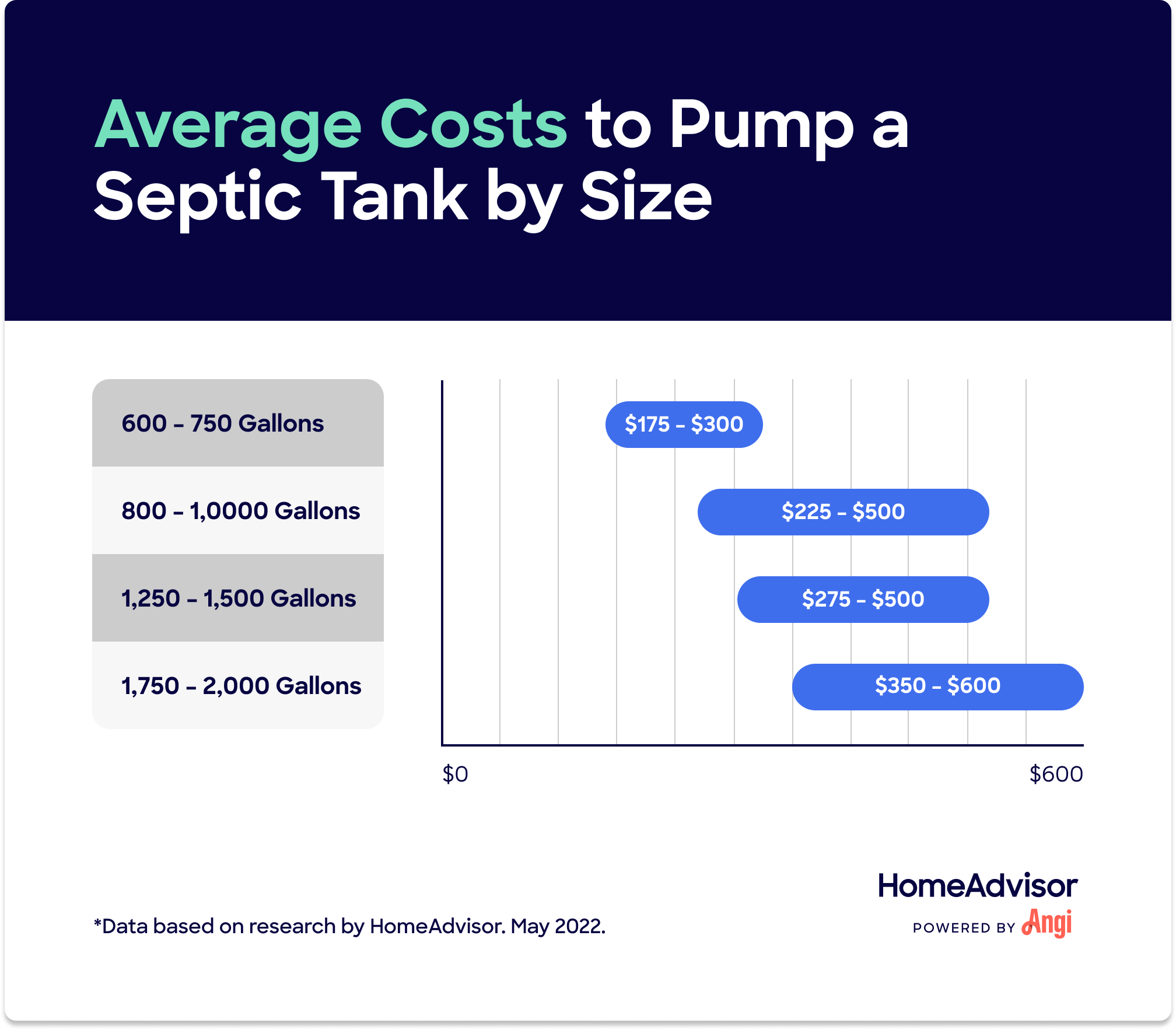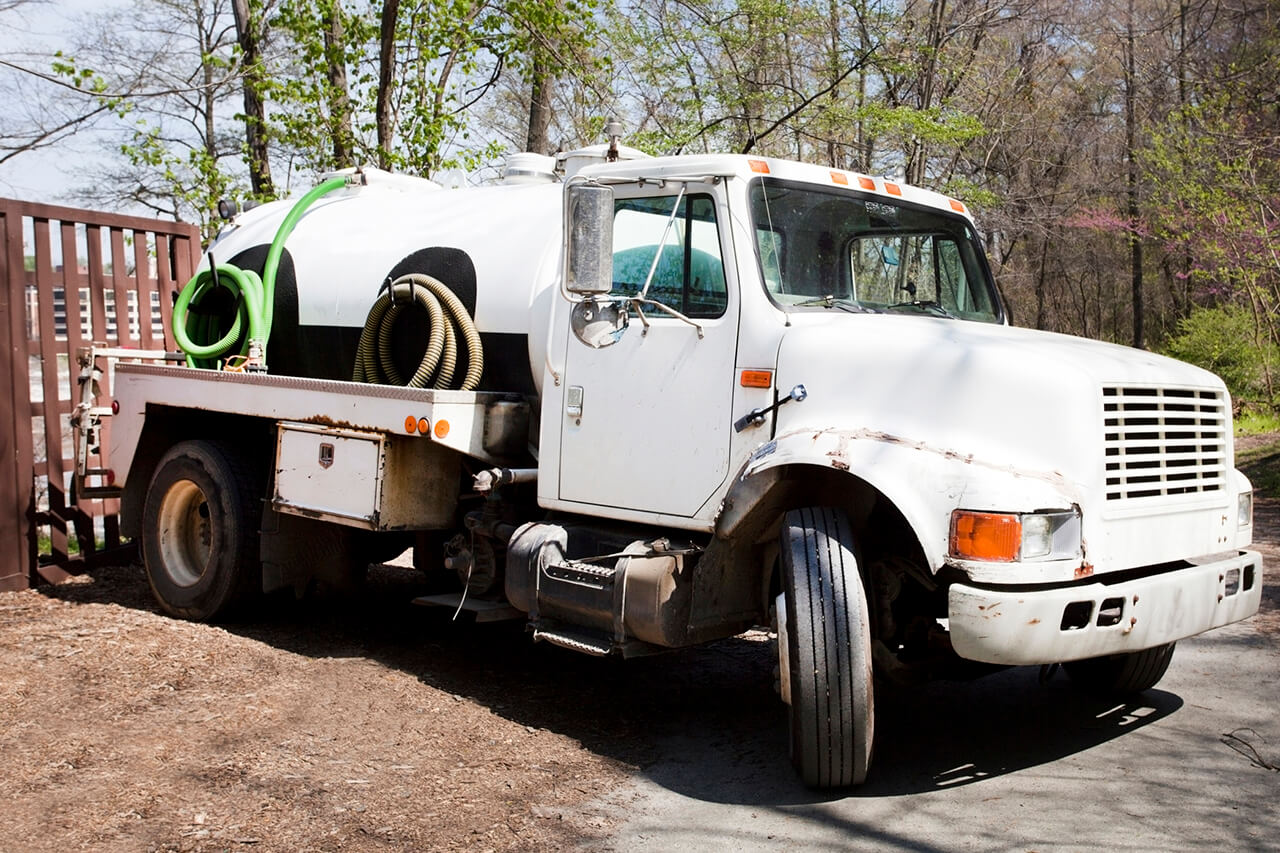How Much Does Septic Tank Pumping Cost?
Typical Range:
$289 - $555
Typical Range:
$289 - $555
Cost data is based on actual project costs as reported by 6,501 HomeAdvisor members. Embed this data
.
.
.
.
.
.
.
.
.
.
.
.
.
.
.
.
.
.
.
.
.
.
.
.
.
.
.
.
.
.
•
•
•
•
Updated April 16, 2024
Reviewed by Jeff Botelho, Licensed Journeyman Plumber.Pumping a septic tank is highly regulated and requires professional tools, making professional service safer and more efficient.
Pumping a septic tank costs $300 for small tanks, $225 to $500 for medium tanks, and at least $600 for large tanks.
The cost of septic tank pumping depends on tank size, number of residents, wastewater generation, and water-saving devices.
Signs your septic tank needs pumping include unpleasant smells, backed up sewage, slowed draining, and pooling water.
Regular septic tank pumping prevents sludge buildup, clogged pipes, broken pumps, and drain field damage.
Highlights were summarized from this existing cost guide text using automation technology and were thoroughly reviewed for accuracy by HomeAdvisor Editor Ryan Noonan.
On average, it costs $422 or between $289 and $555 to clean or pump a septic tank. Extremely large tanks can run $1,000 or more. Most tanks need pumping every three to five years. Inspections cost $300 on average, and you should get one every one to three years.
Let's calculate cost data for you. Where are you located?
Where are you located?
| National Average | $422 |
| Typical Range | $289 - $555 |
| Low End - High End | $200 - $1,240 |
Cost data is based on actual project costs as reported by 6,501 HomeAdvisor members.
Most septic tanks get pumped every three to five years. According to the EPA, you should have it pumped when the scum layer reaches six inches of the outlet tee or the sludge layer within 12 in. of the outlet tee. However, you might clean it out every year or every 10 years depending on several factors:
Tank size
Number of residents
How you generate wastewater
Water-saving devices in the home
Composting
The following table suggests standard pumping frequencies, but you should get an annual inspection by a professional just in case.
| People | Tank Size (gallons) | Frequency (years) |
|---|---|---|
| 1 | 750 – 1,000 | 5 |
| 2 – 3 | 900 – 1,250 | 3.5 |
| 4 – 5 | 1,000 – 1,500 | 2 |
Signs that your tank needs pumping and cleaning:
Unpleasant smells coming from the drain field, tank, or drains in your home.
Backed up sewage in your home or leach field.
Slowed draining inside the house.
Pooling water in the area of the drain field.
Smaller tanks up to 750 gallons typically only cost $300 or less to pump. Moderately sized tanks of 800 to 1,500 gallons cost $225 to $500 to pump, while large tanks up to 2,000 gallons or more cost at least $600 to clean.
The EPA estimates that one in four homes or over 60 million people depend on septic systems in the U.S.
| Long Island, NY | $280 – $550 |
| Concord, NH | $250 – $350 |
| Jacksonville, FL | $240 – $400 |
| Denver, CO | $260 – $350 |
| Portland, OR | $500 – $900 |
| Boise, ID | $280 – $430 |
| Minneapolis, MN | $175 – $275 |
| Phoenix, AZ | $350 – $620 |
| Little Rock, AR | $250 – $500 |
| Milwaukee, WI | $170 – $300 |
Expect to spend anywhere from $100 to $1,000 or more every few years on maintenance.
Septic system inspections cost$100 to $900. The EPA recommends inspections every one to three years, depending on the type. Your pro will do a visual inspection of the system. Adding a complete camera assisted inspection can double the price. It’s usually not necessary.
Adding bacteria to an aerobic system costs anywhere from $50 to $500 depending on the size, type, and any prep work needed. Most homeowners pay in the range of $100 to $200, but you might pay a little less if you combine this with pumping or cleaning.
| Maintenance Task | Cost |
|---|---|
| Inspection | $100 – $900 |
| Pumping | $200 – $600 |
| Jetting | $150 – $450 |
| Effluent Filter Clean/Change | $100 – $200 |
| Sewer Line Inspection Cost | $250 – $1,400 |
| Field Aeration (Fracking) | $1,000 – $2,000 |
The difference between spending $400 every two years vs every five years might come down to how you treat your septic tank and leach field. Consider these tips:
Limit garbage disposal use. To maximize the time between pumping, consider recycling or composting.
Don’t throw coffee grounds down the sink.
If you host many dinner parties, expect frequent maintenance.
Don’t put grease down your drain. This clogs the drain and septic tank.
Spread out laundry loads or divert the water to a separate system. Detergents and cleaners can harm your septic system.
Don’t park on the leach field. It’ll compress the soil, ruining its efficiency.
Don’t build any structure on a leach field.
Just don’t pump your own septic system. Sludge pumped out of the tank must be stored for transport in appropriate containers and disposed of following important safety procedures. This process is usually highly regulated at the local and state levels.
In most cases, homeowners find it easier and more cost-effective to have septic tank pumping done by a professional who has the right tools and storage equipment to handle sludge and scum safely for disposal. It’s always safer, faster, and often more cost-effective to simply hire a local septic pumping professional.
Wastewater from your home from your showers, toilets, sink drains, and washing machines flows to your septic tank. When wastewater enters your septic tank, it divides into three parts:
Sludge: Solid waste sinks to the bottom of the tank, where bacteria in the tank breaks down the solid matter, turning it into sludge.
Water: Blackwater effluent that flows out to your leach field.
Scum: Fats and oils that float to the top of the tank.
Outlet and inlet pipe positions and baffles keep sludge and scum from leaving the tank. Wastewater, the effluent, moves down pipes to the drain field.
If you don’t pump your septic tank regularly (usually every three to five years) a few things happen:
Sludge builds up
The buildup begins seeping into the drain field
Pipes get clogged and sewage backs up
Pumps get clogged and break
You may even end up ruining you drain field
The difference between a cesspool and a septic tank is how they function to disperse waste. The costs to pump them are the same.
A cesspool is simply a lined pit with perforated walls into which wastewater flows and slowly disperses into the surrounding soil. Once the surrounding soil is saturated, you’ll need to dig a new cesspool. In many areas in the U.S., cesspools aren’t permitted, and you’ll need to install a septic system instead.
A septic system operates the same way as a cesspool but with two distinct parts: the tank and the leach field. The tank separates the solids from the liquids, which wash down from the tank into a drain field. The drain field disperses the effluent over a larger area than a cesspool, allowing it to drain through the soil and decontaminate.
Keep your system healthy by keeping some specific materials and chemicals out of your septic system, including:
Chemotherapy drugs and time-release capsules and pills
Anti-bacterial handwashing soap
Some toilet bowl cleaners
Bath and body oils
Some dishwashing detergents
Laundry detergents and bleach in areas where separate systems are now allowed
Some water softeners
It is important to note that while biological additives are unlikely to be harmful, many chemical additives advertised to help you avoid having to pump your septic tank may cause damage to your septic system.

